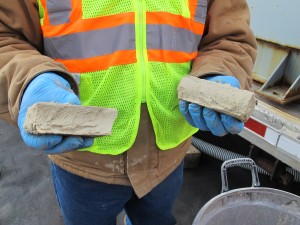High levels of radiation found in creek near drilling wastewater site in western Pa.

SUSAN PHILLIPS / STATEIMPACT PENNSYLVANIA
A worker breaks apart a brick of solid material left over from treating frack water. The solid material, which may contain radioactive elements, gets disposed of in landfills.
A new study published in the journal of Environmental Science and Technology has found high levels of radiation and salinity in a creek near a drilling wastewater treatment facility in western Pennsylvania.
The Duke University study took numerous samples of water discharged downstream of the Josephine Brine Treatment Facility into Blacklick Creek in the Allegheny River watershed from the summer of 2010 to the fall of 2012. Sediment in the creek contained levels of radium that were 200 times greater than normal or background levels, along with high levels of salts like chloride and bromide in the surface water.
These elements come from a naturally occurring brine that is released along with natural gas during the hydraulic fracturing or fracking process. That radioactive brine, known as “flowback,”is either injected back underground or sent to facilities like Josephine where the wastewater is treated and then deposited into rivers and streams.
Professor Avner Vengosh, one of the study’s lead authors, said the radium and salt levels found in the creek are “problematic” and could lead to bio-accumulation of radiation in bugs and eventually, animals further up the food chain like fish.
“That’s why in the U.S. they have a limitation on how much you’re allowed to dispose from a site and to a certain level, to define it as radioactive waste disposal site,” Vengosh said. “The values we measured in the sediments in this site are far, far exceeding these threshold values.”
Spokeswoman Lisa Kasianowitz said the Department of Environmental Protection is already working to address the concerns raised by the study. In May, Fluid Recovery Services, which owns the Josephine facility, signed an agreement that it would not accept or discharge treated wastewater from unconventional formations like the Marcellus Shale until it has installed technology to remove radiation compounds, metals and salts.
Kasianowitz said in an e-mail that the company already stopped taking the flowback fluid in September 2011. At that time, a number of companies in the Marcellus Shale Coalition agreed to stop sending wastewater to a number of facilities, including Josephine Brine.
In a statement, Marcellus Shale Coalition spokesman Patrick Creighton criticized the study for using “outdated data.”
“If, in fact, their findings are legitimate, the researchers would be well-served to look into other potential sources of the increased levels reported in the study,” Creighton said.
The Indiana County facility continues to treat flowback water from conventional wells and Professor Vengosh said his study shows evidence it is also treating Marcellus Shale wastewater as recently as this year.
“The creek’s still receiving that level of salinity and that level of bromide is still flowing and affecting downstream users,” said Vengosh. “So I think this notion that, we just stopped shale gas is kind of ridiculous because we are still contaminating the streams.”
In the fall of 2011, the USGS released a report on radium in Marcellus Shale flowback fluid. The report didn’t address public health issues directly, but concluded that the levels of radiation in Marcellus produced water is far higher than the resulting flowback water in other formations.
Last spring, the state DEP launched a year-long study to examine radioactivity associated with oil and gas development. However, before the study began, a spokesman for the agency said they do not believe the public faces any kind of risk.
The same scientists who conducted this latest research also conducted a controversial 2011 study which found methane levels in wells near hydraulic fracturing sites were 17 times higher. In June, they published another study which analyzed 141 water wells near shale gas sites in northeastern Pennsylvania showing methane levels were six times higher, and ethane levels were 23 times higher. This study was sponsored by the Park Foundation that has supported efforts by anti-drilling groups.
Former DEP Secretary Michael Krancer, who now works as an attorney representing energy companies, attacked the 2011 research as “bogus” and the scientists pushed back, challenging the DEP to share more data.
















